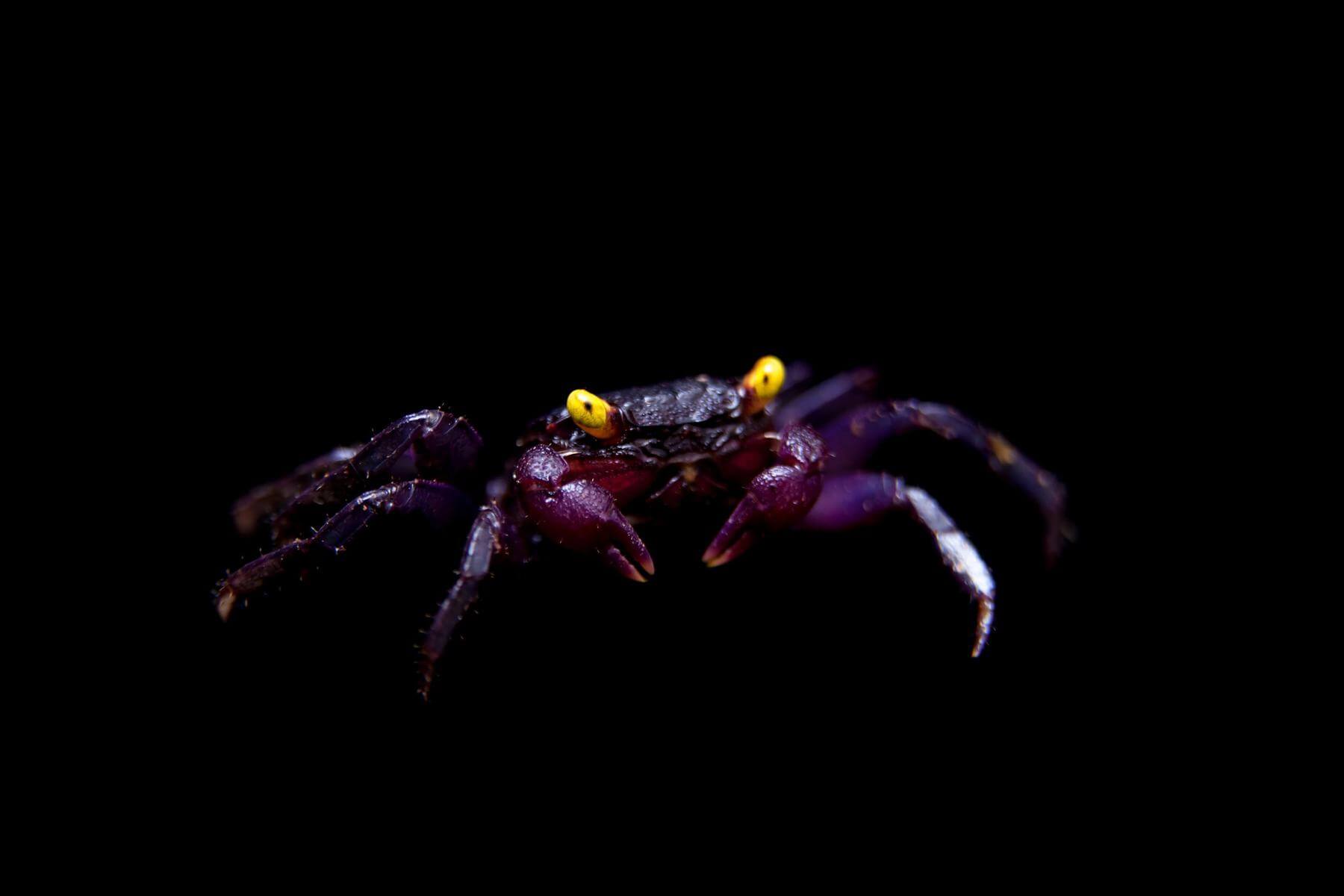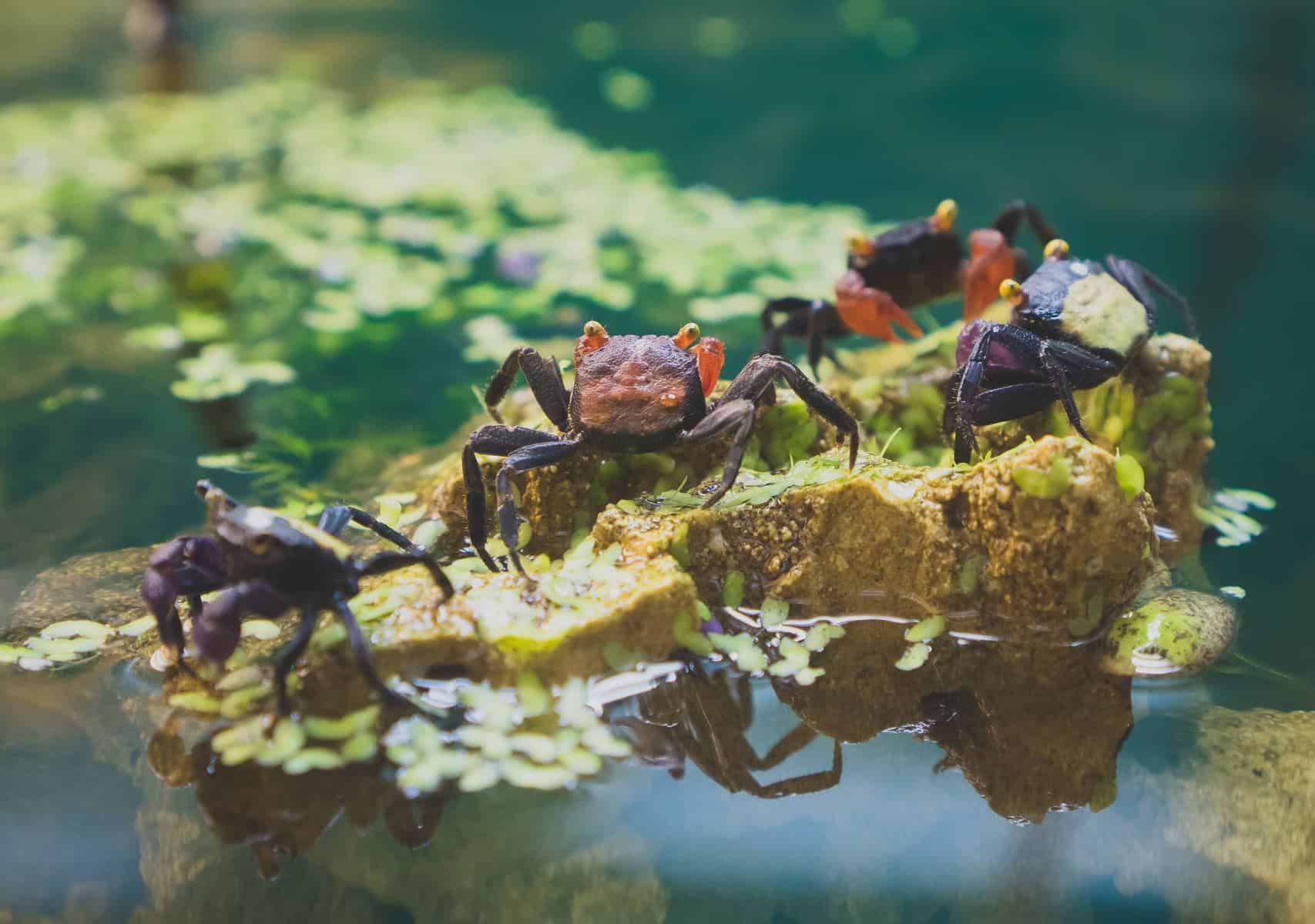If you don’t want to restrict your fishkeeping hobby to only fish, you might fancy taking on a few unusual invertebrates instead, maybe in a separate tank.
When you mention invertebrates, most people assume you’re talking about shrimp. But in this guide, we introduce the vampire crab. These small, beautiful crustaceans are taking the hobby by storm and they’re today’s must-have critter!
To find out what all the hype is about and to discover whether this fascinating type of crab could be a good choice for you, read on!
Are vampire crabs good for beginners?
Yes! Vampire crabs make a really good choice of pet for beginners, as they’re easy to keep, provided you give these little critters a healthy diet and keep their tanks clean.
You can even keep a few tank mates with your crabs, so long as you choose the right ones.
What are vampire crabs?
Vampire crabs are sold in many fish and pet stores. The crabs’ scientific name is Geosesarma sp., and they make up the whole genus.
These crabs are found throughout the Pacific and Southeast Asia, ranging from India, Java, and Krakatau right through to Hawaii. Despite the crabs’ popularity and the fact that they’ve been kept as pets for many years, their origins remain unknown, and the species wasn’t first described until as recently as 2006.
Natural habitat
Vampire crabs inhabit the warm, slightly alkaline freshwaters of lakes and river edges where there’s little or no current. That enables the crabs to live both in the water and on land, too.
During the daytime, the crabs hide away among dense plants both in the water and on land or take shelter in caves. The habitat where the crabs live is typically rocky and heavily vegetated.
How long do vampire crabs live in captivity?
In both the wild and captivity, these crabs have a lifespan of around two years, as long as you feed them properly and provide them with clean water.
Why are they called vampire crabs?
You may be relieved to learn that these inoffensive little crabs didn’t earn their common name because they drink the blood of other creatures! Vampire crabs are called that because of their spooky yellow eyes and purple Dracula cloak-colored bodies.
Can vampire crabs live underwater?
These crabs are classified as semi-terrestrial. That means the creatures need to spend part of their time on land and remainder in the water. In captivity, you must provide the crabs with somewhere they can get out of the water, or they’ll drown.
You’ll have plenty of chances to observe the crabs, as they spend much of their days sitting in their preferred spots in the tank. That said, these crabs are primarily nocturnal, so they do most of their feeding and other activities at night.
How often do vampire crabs molt?
Crabs have a protective exoskeleton to keep them safe from predators. That hard shell doesn’t grow with the crab. When the creature outgrows the shell, it must discard it and grow a new, larger one through a process called molting.
Vampire crabs molt once a month, although the process can be more frequent when the crabs are younger, as they are growing more rapidly. Once the old shell has been molted, the crab will hide away in a safe place until its new carapace has hardened.
When the crab has finished molting, remove the old shell from the tank, and leave the crab in peace until it emerges from hiding with its new exoskeleton.
Are vampire crabs aggressive?
Unfortunately, vampire crabs can be aggressive. You can safely keep groups of these crabs together without incident, but they will attack and eat small fish and other species of crab.
The same applies to keeping vampire crabs with shrimp, which they would most likely finish up as lunch.
What do vampire crabs look like?

Vampire crabs are truly beautiful animals that make a stunning display in a single-species terrestrial aquarium setup.
These crabs have 10 legs, including their small pincers, which are deep purple. The crab’s carapace is indigo-colored with white spots that give the creature the appearance of a star-spangled night sky.
The animal’s brilliant yellow eyes are set on stalks that stand slightly proud, contrasting strikingly with the vampire’s dark and sinister coloration.
Vampire crabs grow to reach a size of around two inches, including their legs. The animal’s body is only an inch or so wide.
How to tell a female from a male vampire crab
Male vampires are slightly larger than females, and their claws are lighter in color. However, the most obvious difference between the two sexes is the abdominal flap. Take a peek underneath the crab. Females have a wide, rounded flap, whereas the male has a more pointed flap. Sometimes, you’ll spot some fertilized eggs under the flap, meaning the crab is a female.
How to care for vampire crabs
Now that you know more about these slightly creepy crustaceans, you may be seriously considering getting one. So, here’s all the information you’ll need for vampire crab care!
Tank size
Vampire crabs are very small, so you can keep them in a small tank. We recommend an aquarium of at least 10 gallons for a group of up to six crabs. If you want to keep more than that, you’ll need to increase the size of your tank accordingly.
Tank set-up
Since vampire crabs live both on land and in water, you’ll need to set up a tank that has an 80:20 land to water ratio. You can create the land element of the habitat by using banks of the substrate, building rockwork structures, or even including floating resin log platforms.
These creatures like to seek shelter, especially when they’re molting. So, be sure to provide plenty of hiding places, especially in the water. Caves, driftwood, and carefully arranged smooth stones are perfect for serving that purpose.
As mentioned above, the crabs’ natural environment is heavily vegetated, as you need to reflect that in the captive habitat. You can use aquatic and semi-aquatic plants — whichever appeal more to your taste.
The crabs won’t damage the plants, though they’ll most likely eat dead plant matter.
Water parameters
Even though you won’t have very much water to worry about, what little water is present must be kept clean. You’ll need to install a filtration system to clean the water just as you would in a fish tank. Similarly, partial water changes are necessary each week to keep nitrate levels to a minimum.
Vampire crabs are highly sensitive to poor water conditions, so you’ll have to test it weekly to catch any problems before they have a chance to affect the crabs.
Water temperature should be kept between 70 and 82 degrees Fahrenheit, and the pH levels should be between 7.5 and 8.0.
In the crabs’ wild habitat, the environment is humid, so you’ll need a humidifier to maintain the humidity levels at around 75 percent.
Lighting
The lighting in the tank can be chosen to suit your plants, as the crabs don’t have any specific light requirements.
Vampire crabs are mainly nocturnal, so if you want to watch your pets going about their regular routines, you’ll need to choose a LED lighting unit that has a moonlight setting.
Tank maintenance
Maintaining these crabs’ tanks is similar to taking care of a fish tank. You’ll need to carry out partial water changes each week and vacuum the substrate to remove waste.
The most time-consuming act of tank maintenance will be tending to the plants, removing dead leaves, and cutting back overgrowth.
Tank mates

As mentioned previously, vampire crabs will prey on small fish, crabs, and shrimp. However, if you choose tank mates for your pet vampire crab carefully, creating a harmonious community is possible.
Fish should be larger than the crabs and, ideally, non-aggressive species. Obviously, you’ll need to avoid any species that is known to eat crabs. Similarly, larger species of crabs should be avoided as well, as they may prey on the vampire species.
Large snails make a safe choice, as neither species will bother the other.
Can you keep vampire crabs together?
Vampire crabs get along fine when kept together, and a small group of them makes a nice display.
These crustaceans generally don’t squabble, except during the breeding season when males compete for females. You can take steps to prevent that from happening by keeping a ratio of one male to two females.
If you end up with more males than females in your setup, be sure to provide the crabs with plenty of space and give them lots of caves, overhangs, and dense plants to hide in if necessary.
Diet
It’s essential that you give your crabs a good, nutritious diet. High-quality food keeps them healthy, encourages growth, and helps build a strong exoskeleton after molting.
What do vampire crabs eat, you ask?
In the wild environment, these crabs are scavengers, eating both dead plant matter and meaty foods like insects and small fish. That makes feeding these crabs in captivity pretty straightforward.
We recommend giving your vampires a mixture of live and frozen foods with a small number of flakes, algae wafers, and pellets. That’s better than only giving them dried food, which loses some of its nutrient content during processing. Feed your crabs brine shrimp, bloodworms, earthworms, and crickets.
Their diet should contain plenty of calcium, which is crucial for the development of a healthy, strong carapace. So, veggies like broccoli and spinach are excellent additions to the crabs’ diet.
How often should you feed your vampire crabs?
You only need to feed your crabs once a day. Crabs are scavengers and will quickly find detritus and organic matter to eat in the tank if they get hungry between feeds.
Since these crabs are nocturnal, you should feed them just before or after lights out at the end of the day. It’s good to have an adjustable LED lighting unit with a moonlight setting so you can observe the crabs when they’re most active. That also enables you to make sure the crabs are eating properly.
Health and disease
Vampire crabs are generally pretty robust creatures that will remain healthy if you give them adequate tank conditions and feed them a nutritious, balanced diet as described above.
However, if you do need to use any kind of chemical medication in your tank, don’t use anything with copper. Copper is highly toxic to invertebrates and may kill your crabs.
Although crabs don’t suffer from many of the common fish diseases, like white spot disease, they can be vectors of these diseases and others. For this reason, you should always quarantine the crabs before adding them to a community set-up that contains fish.
Vampire crabs can, however, be susceptible to fungal and bacterial infections, and they’re sometimes attacked by parasites.
Calcium deficiency
Watch out for signs of damage to the crabs’ shells that could indicate a lack of calcium in their diets. If necessary, feed them more fresh vegetables and monitor their condition over time.
Breeding vampire crabs
If you’re hoping to breed these crabs to compensate for their relatively short lifespan, that, quite frankly, is going to be very challenging.
Crabs are sexually mature at about six months old, and they’ll continue to reproduce for the remainder of their lives.
When the female crab is carrying eggs, the male fertilizes them by climbing on top of the female. The eggs usually hatch after a month or so, producing 20 to 80 fully-formed baby crabs. Once the youngsters appear, it’s best to remove them and put them in a separate tank if possible, as the parents and other tank residents may eat them.
If you do manage to successfully breed your vampire crabs, we want to hear all about it; after all, raising these beautiful creatures is not easy. Tell us about your experience in the comments below!
Are vampire crabs readily available?
Many pet stores sell vampire crabs, but you can buy them online, too. Vampire crabs typically cost around 10 to 20 dollars, with the larger specimens being more expensive than small ones.
Do vampire crabs make good pets?
Vampire crabs are extremely easy to care for, which makes them a good choice for a beginner who’s looking to keep something other than fish.
Make sure you provide the crabs with the right environmental conditions and tank setup, feed them a nutritious and balanced diet that contains plenty of calcium for healthy shell development, and you shouldn’t have any problems.
The main drawback to keeping these crabs is that, although they’re generally healthy and robust creatures, they don’t have a very long lifespan. Also, breeding vampire crabs in the home tank is not easy to do, so you won’t be able to easily replace your pets as they die.
All that said, vampire crabs are a beautiful and very unusual choice of pet that will certainly make a great conversation starter when your friends come to visit you.


























